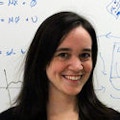Katherine Cora Ames, Ph.D.
Columbia University
Katherine Cora Ames was a postdoctoral fellow at Columbia University, working in the labs of Mark Churchland and Larry Abbott, and will begin a position as a senior application scientist at LifeCanvas Technologies in 2020. She conducted undergraduate studies at the University of Chicago, where she graduated with a B.S. in mathematics in 2009. She received her Ph.D. in neuroscience under the supervision of Krishna Shenoy at Stanford University in 2014. Ames uses a combination of theoretical and experimental techniques to study the principles of motor control. This enables her to leverage models to generate hypotheses about how the brain might perform different tasks, and then to design and perform experiments to compare these models’ predictions with neural data. She is particularly interested in studying how dynamical principles of motor control can be applied to a wide array of behaviors and in how different brain regions communicate with each other to drive complex movements.
Project: Dynamics of neural coordination across hemispheres
It is well known that one side of the brain controls the movements of one side of the body — the opposite side, as it turns out. Yet what happens when moving both sides of the body? Do the two hemispheres act independently, do they help each other or do they interfere with each other? The answer may be more complicated than thought. For example, walking is effortless, implying the two sides of the brain work together. Yet it is easier to tap hands at the same rate than to tap one at a rate three times faster than the other. Or it is easier to draw simultaneous circles with each hand if you draw them at the same rate and in the same direction. These observations imply that the two sides may interfere with each other, at least in some cases. Working in monkeys, this project will study the neural activity that gives rise to these interactions between movements by training the animals to control a so-called “stationary bicycle” with their hands. In the task, the monkeys will pedal the stationary bicycle with their hands. Unlike a real bicycle, however, each pedal can be controlled independently. The monkey will be required to pedal with just one hand or with both. When pedaling with both hands, the monkey will pedal with the hands in and out of phase with one another. In this way, the researchers can test how the brain deals with differing degrees of coordination of bilateral movements. While the monkeys perform these tasks, the researchers will record the electrical activity from neurons in the part of the brain that controls movement, the motor cortex. They will also build computational models of two interconnected networks and ask under what conditions they do or do not interfere with each other. They can then examine the neural activity from our experiments to determine whether the computational model predicts which strategy the brain actually uses. Such a back-and-forth between modeling and experiments will allow the researchers to gain insight into how multiple brain areas coordinate complex movements. Since most movements involve both sides of the body, this research will shed light on how the majority of movements are carried out.